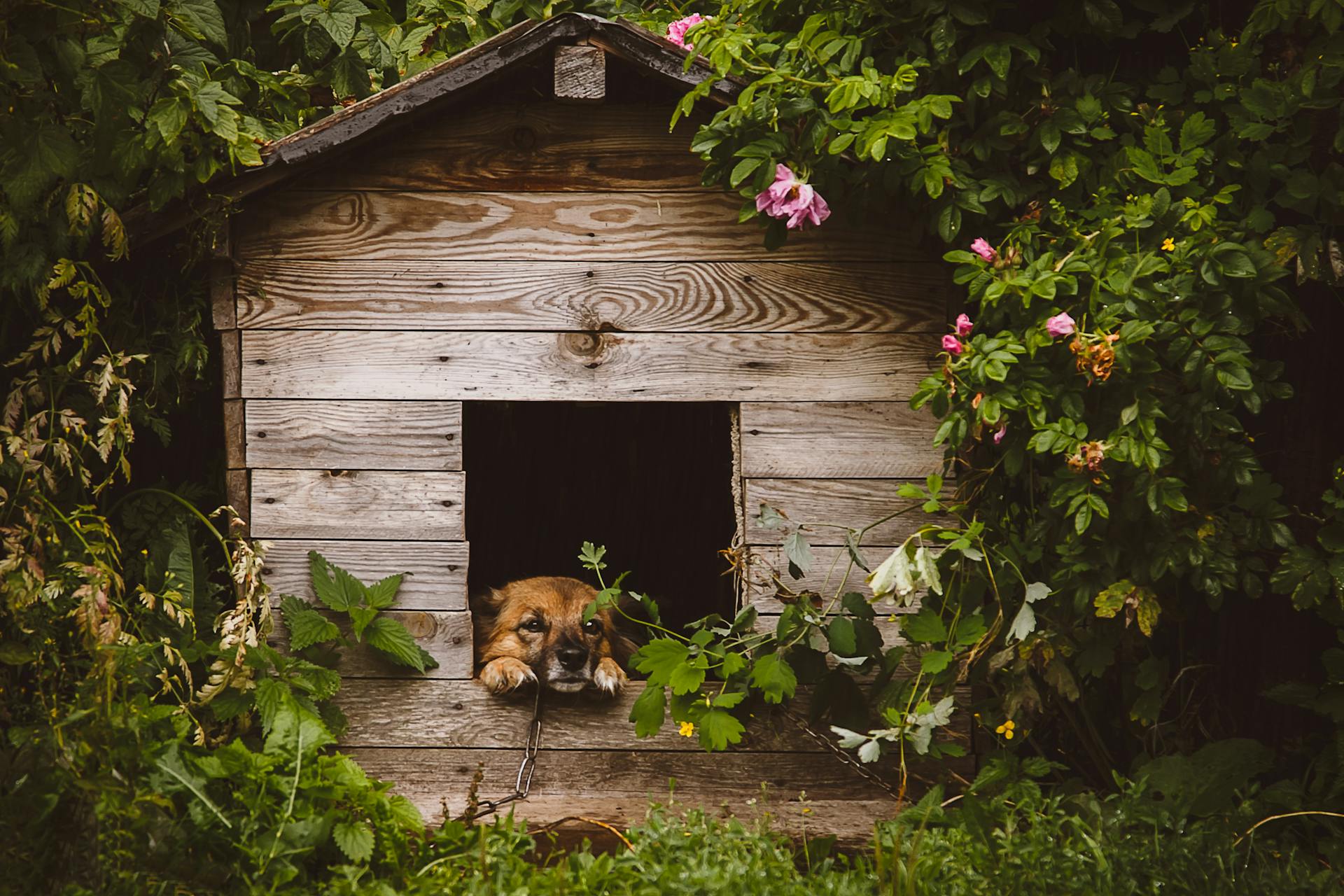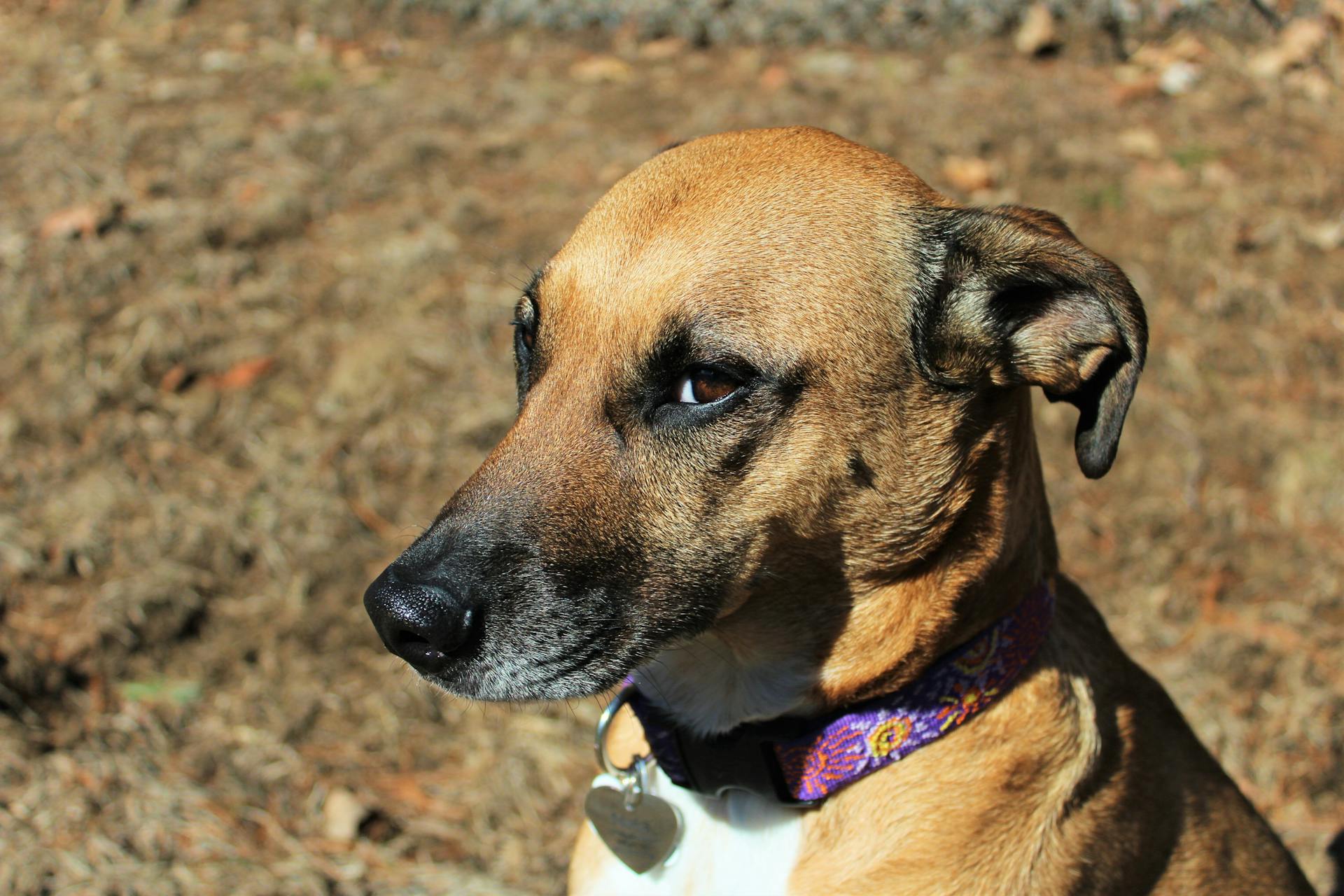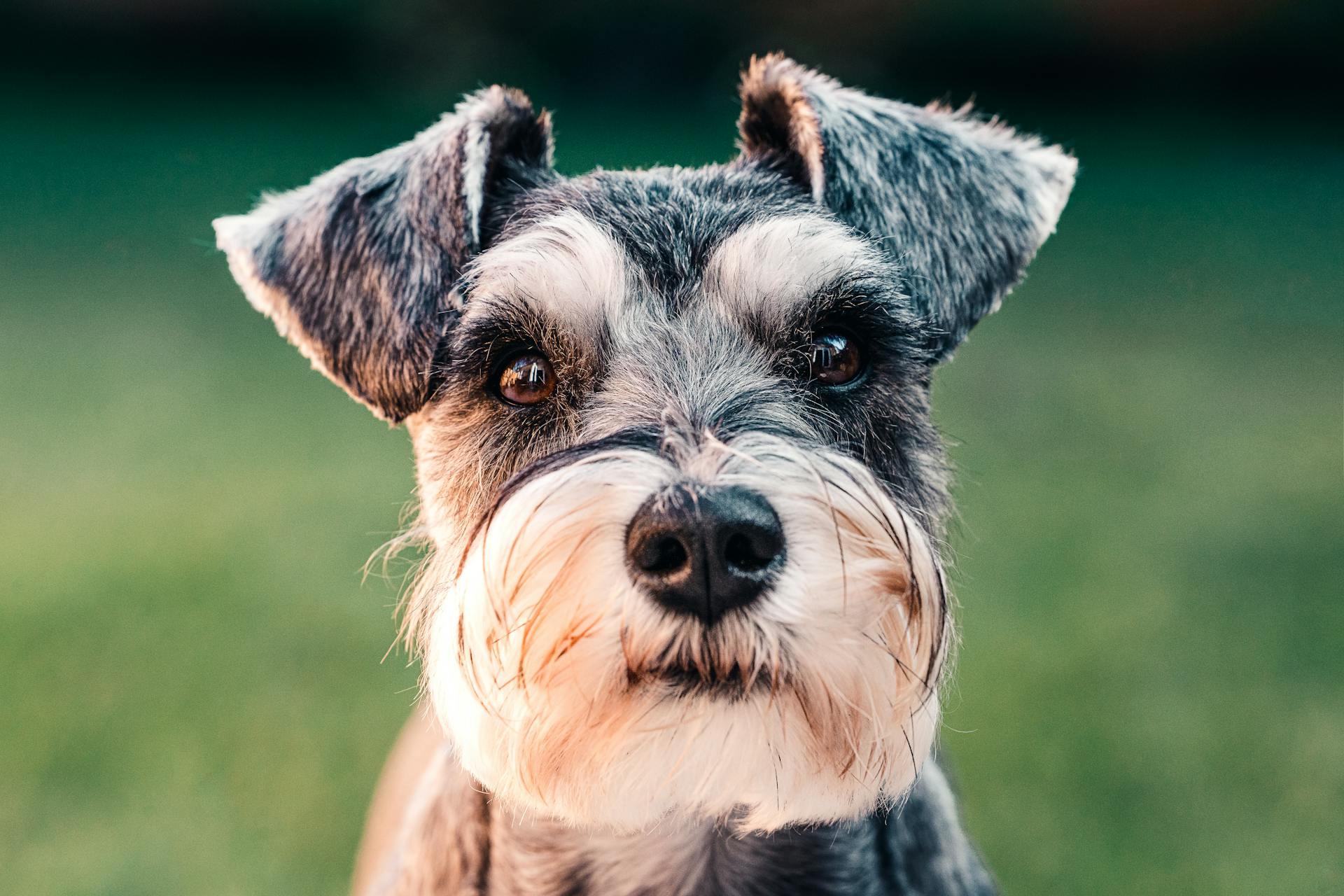
To ensure the health and well-being of the dogs in their care, dog boarding facilities must meet specific requirements. These requirements include having a veterinarian on staff or on call to provide medical attention if needed.
The facility must also have a plan in place for emergency situations, such as a fire or natural disaster. This plan should be regularly reviewed and updated to ensure it remains effective.
Dogs in boarding facilities need regular exercise and socialization to prevent boredom and stress. This can be achieved through playtime in a secure outdoor area or indoor playrooms.
The facility must also provide a safe and comfortable place for dogs to rest and relax, with adequate ventilation and temperature control.
Suggestion: Dog Boarding Facility Requirements
Definitions
Dog boarding requires a clear understanding of the terms involved. Boarding refers to the taking of custody or possession of a dog for keeping, accommodation, care, training, or feeding at a property other than its normal place of residence.
There are different types of boarding, including overnight and day boarding. Overnight boarding means the animal stays at a facility for at least one night, while day boarding means the animal is housed during the day only and is not housed overnight.
Vaccination is also an important aspect of dog boarding. Vaccination means vaccination against distemper, hepatitis, parvovirus, and kennel cough (parainfluenza (Type II) virus and Bordetella bronchiseptica).
The term "animal" is defined in the code as a dog, cat, puppy, or kitten. This definition is crucial for understanding the scope of dog boarding requirements.
Here are the different types of boarding facilities:
- Day boarding: Animal is housed during the day only and is NOT housed overnight.
- Overnight boarding — Animal stays at facility for at least one night.
- Home boarding: A maximum of two animals boarded at a place of residence occupied by the animal carer where no other form of boarding is occurring on the same property.
Admission Requirements
Admission Requirements are in place to ensure the health and safety of your furry friend while they're at the boarding establishment. All animals must be identified and any special requirements requested by the owner or attending veterinary surgeon must be met.
Administration of medication, feeding special diets, bathing, and grooming are all examples of special requirements that must be accommodated. This ensures that your pet receives the care they need while you're away.
Pups between 10 to 16 weeks can be admitted to day boarding facilities, but only if they've received their first vaccination at least 8 days prior to admission and are continuing their recommended vaccination schedule. This is crucial to prevent the spread of disease.
If you're planning to board your pup during this age range, be prepared to receive information on the risks of disease contraction and give written approval or acknowledgment of these risks. It's essential to be aware of the potential risks and take necessary precautions.
Dogs older than 16 weeks must meet the vaccination requirements outlined in Section 4.2. This ensures that all dogs are up-to-date on their vaccinations and protected from diseases.
Pups between 10 to 20 weeks being boarded at day facilities must be supervised visually and physically at all times while being housed with other pups or dogs. This close supervision helps prevent any potential conflicts or health issues.
Here's a quick summary of the age restrictions for boarding:
- Pups between 10 to 20 weeks: Supervised boarding only
- Dogs less than 4 months old and cats less than 3 months old: Overnight boarding is not allowed, except in exceptional circumstances
Facilities and Environment
A well-designed facility is crucial for your dog's comfort and well-being. Each animal boarding establishment must provide an area for reception, records storage, and washing and toilet facilities for staff.
The boarding facilities must be designed to prevent escape or injury to humans and ensure the good health and well-being of the animals. This includes protection from the weather, vermin, and harassment from other animals.
The flooring of the facility must be watertight, sealed, washable, and non-slip. Temperature, humidity, and ventilation must also be considered, with adequate ventilation to keep animal housing areas free of dampness, noxious odours, and draughts.
Adequate fire extinguishers or other fire protection must be provided in the facilities.
Here are some acceptable materials for constructing facilities:
- brick
- concrete
- timber
- iron
- similar solid material
- chain mesh manufactured from 3.15 mm wire to form a uniform 50mm mesh
- 4mm weld mesh wire with a maximum mesh spacing of 50mm.
Hygiene
Hygiene is a top priority in any animal boarding establishment. The facility must be clean and hygienic at all times, with all pens and yards cleaned out at least once a day, or more often if needed.
All used bedding and litter must be removed before cleaning to ensure the pen is fresh and clean. Used litter and uneaten food must be placed in sealed containers for disposal.
Animal boarding establishments must have an adequate water supply and must be sewered or on a septic system, or have another adequate method of disposing of faeces and other wastes.
Waste disposal and drainage discharge points must meet the requirements of the relevant government authority. Using a trade waste service for collection and disposal of wastes is preferable.
Cats must be provided with clean litter trays daily, and litter trays must be disinfected regularly. Suitable litter materials include commercial cat litter, sawdust, or shredded paper.
Disinfection of pens and cages must be done whenever the pen/cage is vacated, or every seventh day with hospital-grade disinfectants. Always follow the manufacturer's instructions for the use of these agents.
Here are some approved materials for constructing animal enclosures:
- brick
- concrete
- timber
- iron
- similar solid material
- chain mesh manufactured from 3.15 mm wire to form a uniform 50mm mesh
- 4mm weld mesh wire with a maximum mesh spacing of 50mm
Facilities

Facilities are a crucial aspect of any animal boarding establishment, and they need to be designed and maintained with the animals' health and well-being in mind. Each establishment must provide a reception area, records storage, and washing and toilet facilities for staff.
The boarding facilities themselves must be constructed and serviced to prevent escape or injury to humans, while also protecting the animals from the weather, vermin, and harassment from other animals.
Flooring in indoor facilities should be watertight, sealed, washable, and non-slip to prevent accidents and make cleaning easier.
Temperature, humidity, and ventilation are also essential considerations in indoor facilities. The air change rate in totally enclosed buildings should be between 8 to 12 changes per hour to prevent the buildup of foul odors.
In addition to these general requirements, facilities must also have appropriate fire extinguishers or other fire protection measures in place.
When it comes to enclosures, fencing between them must be in good condition to prevent dogs from escaping or getting injured. The table below outlines the minimum requirements for enclosure size and dog numbers:
Suitable rest areas must be provided for dogs being boarded, and these areas must be separate from the enclosure floor area. The size of the rest area depends on the number of dogs being boarded, as outlined in the table above.
Our

Our facility takes sanitation very seriously. We don't allow beds or blankets from home to prevent the spread of bed bugs, fleas, and ticks. Instead, we provide clean blankets and beds for our tier two dogs.
We also have a strict policy on toys from home. Due to the risks of Covid-19, we no longer accept them. However, we provide a Kong toy at no charge for dogs who will use it, and we can re-stuff it daily for a small fee.
You may be wondering what you should bring when dropping off your dog. While some facilities may allow favorite toys and blankets, ours has specific rules. We recommend bringing your dog's favorite toy, food, and a piece of clothing with your scent to help them feel more at home.
Here's a list of items we provide to make your dog's stay more comfortable:
- Beds and blankets for tier two dogs
- A Kong toy at no charge for dogs who will use it
- Add-on chews available for purchase, including Natural Beef Bones, Beef Trachea, and Beef Cheek Rolls
If your dog has a health condition, be sure to ask about our accommodations. We may need to provide special care or supplements to ensure their comfort and safety.
Daily Kennel Activities
A thriving boarding kennel is essentially a summer camp for dogs, offering frequent playtimes, face-to-face contact with the staff, and regular interactions with other dogs. This is especially true for social dogs who thrive in the company of their pack.
Some dog boarding facilities offer detailed daily itineraries, which can be a great way to ensure your dog gets the exercise and attention they need. These itineraries might include training exercises to help your dog brush up on basic obedience skills.
Training exercises are a great way to keep your dog's mind and body active, whether they're a puppy or a seasoned pro. Many kennels have staff on hand to teach skills like "sit" or "leave it".
Playtime with hand-picked groups of dogs is another essential part of a kennel's daily activities. This helps ensure dogs get adequate exercise and have fun while doing it.
Water-based activities are a major draw for owners of water-loving dogs, such as Labrador Retrievers and English Springer Spaniels. Many kennels have inflatable swimming pools, hoses, and sprinklers to cool off dogs on hot days.
To ensure your dog's safety, it's essential to ask about the kennel's emergency procedures. This includes whether they have a veterinarian on staff or work with local veterinary services in case of an emergency.
Consider reading: Top Dog Boarding Kennels
Care and Supervision
At a dog boarding facility, the number of staff members required depends on the number of dogs being boarded. For every 10 dogs over 40, you must add one extra staff member.
According to Table 3, if you have 1-17 dogs, you need at least one staff member, and they can be separated into at least three separate enclosures with no more than six dogs per enclosure.
For example, if you have 15 dogs, you would need one staff member, and they would need to separate the dogs into at least three enclosures, with no more than six dogs in each.
To ensure the dogs receive proper care, the staff must be in visual and audible range of the animals at all times, especially if the enclosures are separated by a physical barrier, such as different rooms.
The staff numbers and animals per enclosure must at least meet the requirements of Table 3, which is summarized below:
Animal Attendants
Animal attendants play a crucial role in ensuring the health and well-being of animals in a boarding establishment. They are responsible for daily feeding, watering, and inspection of all animals, as well as daily cleaning of facilities.
Animal attendants must be appropriately trained and experienced to manage the type of animal boarded. This includes exercising dogs as required by the manager.
A key aspect of animal attendants' responsibilities is monitoring animals for any signs of illness or distress. If an animal shows symptoms such as a runny nose, runny or inflamed eyes, or repeated sneezing, the attendant must report it to management immediately.
Animal attendants must also take steps to prevent the transmission of zoonoses, or disease-causing organisms that can be transmitted to humans. This includes following personal hygiene procedures and being aware of the risk of contracting toxoplasmosis, especially for women of childbearing age who work with cats.
Animal attendants are required to report any serious physical or behavioral abnormalities to management, including lameness, inability to stand or walk, bleeding or swelling of body parts, and difficulty or inability to urinate or defecate.
A unique perspective: Animals Dogs and Cats
Here are some examples of symptoms that require immediate attention:
- Runny nose
- Runny or inflamed eyes
- Repeated sneezing
- Coughing
- Vomiting
- Diarrhea, especially if bloodstained
- Lameness
- Inability to stand or walk
- Bleeding or swelling of body parts
- Weight loss
- Lack of appetite
- Apparent pain
- Fits or staggering
- Bloating of abdomen
- Difficulty or inability to urinate or defecate
- Red or brown-colored urine
- Any other serious physical or behavioral abnormality
Husbandry
Good animal care starts with providing a comfortable and safe environment. All animals need a permanent supply of fresh, clean water.
To ensure this, food and water containers must be non-spillable, making it easier to prevent messes and keep your home clean.
Supervision
Supervision is crucial for ensuring the well-being of the animals in the facility. At least one staff member must be in visual and audible range of animals in each enclosure at all times.
The number of staff members required depends on the number of dogs at the facility. For facilities with 1-17 dogs, at least one staff member is needed, with a maximum of 6 dogs per enclosure.
Table 3 outlines the minimum number of staff members required for facilities with different numbers of dogs. Here's a summary of the table:
For example, if a facility has 25 dogs, at least two staff members are required, with a maximum of 12 dogs per enclosure.
Pick Ups/Abandonment

We take the responsibility of picking up your pup very seriously, so be sure to mark your calendar for their final day of stay.
If you're unable to pick up your dog on their scheduled departure day, we'll attempt to contact you to confirm.
All attempts to reach you will be made before we consider your dog abandoned.
In accordance with PA State Law, a dog will be considered abandoned after ten days if we're unable to reach you.
Abandoned dogs will become the property of Dog Sense LLC, and we'll work to re-home them.
Recommended read: Will Shiba Inu Coin Reach $1
Spay/Neuter
Spay/Neuter is a crucial aspect of caring for your dog, especially when it comes to socialization and behavior. Dogs over 6 months should be spayed or neutered prior to pack socialization.
Dogs that start daycare before 6 months may be allowed to remain unaltered until 9 months, as long as they're not exhibiting hormone-related behaviors.
Unaltered females approaching or past their first heat cycle won't be allowed at daycare until after they've been spayed and healed. This is to prevent unwanted breeding and reduce aggressive behavior.
Social settings can be risky for unaltered dogs, and their behavior can put their physical and mental health at risk.
What to Expect When Picking Up
Picking up your dog from a kennel can be a great moment, but it's essential to know what to look out for. Your dog should be tired from a day filled with playtime and healthy interaction.
You should also check if your dog has shown signs of distress, such as excessive panting, drooling, or a stiff body. If they're healthy and happy, that's a great sign!
When you arrive to pick up your dog, they should be happy to see you, not just relieved. If you notice any apprehension or uncertainty, it may be a sign that your dog isn't suited for overnight kennel stays.
Here are some key things to look for when picking up your dog from a kennel:
- They're tired from a day filled with playtime and healthy interaction
- You don't see signs of distress, such as excessive panting, drooling, or a stiff body
- They're just as healthy as they were when you dropped them off, meaning they're free of bruises, cuts, and scratches
Frequently Asked Questions
What injections do dogs need to go into kennels?
For dogs going into kennels, Bordetella (Canine Kennel Cough) and Rabies vaccinations are typically required, but check with the kennel for specific requirements as they may vary. It's essential to ensure your dog is up-to-date on these vaccinations before booking a kennel stay.
How long do dogs need kennel cough vaccine before boarding?
To ensure your dog is protected against kennel cough, they should receive the kennel cough vaccine at least 2 weeks prior to boarding. This allows the vaccine to take effect and provide optimal protection against the highly contagious disease.
How to prepare a dog for kennel?
Before boarding, prepare your dog by visiting the kennel, researching their health and exercise needs, and ensuring you have emergency contact information. This includes avoiding contact with other dogs for 7-10 days beforehand to prevent health risks.
Sources
- https://agriculture.vic.gov.au/livestock-and-animals/animal-welfare-victoria/domestic-animals-act/codes-of-practice/code-of-practice-for-the-operation-of-boarding-establishments
- https://www.dogsensepa.com/boarding-policies
- https://www.akc.org/expert-advice/travel/dog-boarding-tips/
- https://www.dogsnaturallymagazine.com/dog-boarding-what-to-look-for/
- https://waggintailsdogresort.com/requirements/
Featured Images: pexels.com


